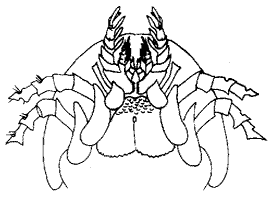
| Palaeos |  |
Eurypterida |
| Arthropoda | Hibbertopterina |
| Page Back | Unit Home | Page Next | Page Up | Page Down | Arthropods | Chelicerata | Dendrogram |

The Hibbertopterina were mostly large animals, many of which may have ventured onto land, flourishing in the moist Permo-Carboniferous coal swamps. The outer surface of the skin is armed with spiny scales. The prosoma is subsemicircular, strongly convex; the compound eyes almost in the middle of the head ("subcentral"), with inflated angular lobes between them. The abdominal tergites are convex. The posterior (last) prosomal legs have a basal extension, which is a distinguishing mark of the group.

 Family Mixopteridae Caster & Kjellesvig Waering, 1955
Family Mixopteridae Caster & Kjellesvig Waering, 1955
"...it was Hibbert (1836) who discovered the first eurypterid in the quarry, Hibbertopterus scouleri (above). Under more recent scrutiny there have been three genera of generally poorly preserved eurypterid found in the East Kirkton Limestone [early Carboniferous - Visean epoch - Scotland). Jeram and Selden (1994) suggest that these appear to have been washed into the depositional area, due to the lack of juveniles in the assemblage. They believe that the eurypterids found here are semi aquatic. They cite the rarity of complete specimens and abundance of cuticle fragments in horizons rich in pulverized plant debris as evidence for the eurypterids living immediately around the lake and not permanently within it. Jeram and Selden propose that the eurypterids preyed on small invertebrates (one genera using paddle-like filters to extract them from the sediment) and possibly brine shrimps which would have inhabited pools around the lake." reference
page uploaded 12 June 2002
checked ATW040206
(originally uploaded on Kheper Site 3 October 2000)
text by M. Alan Kazlev Creative Commons Attribution 2000-2002